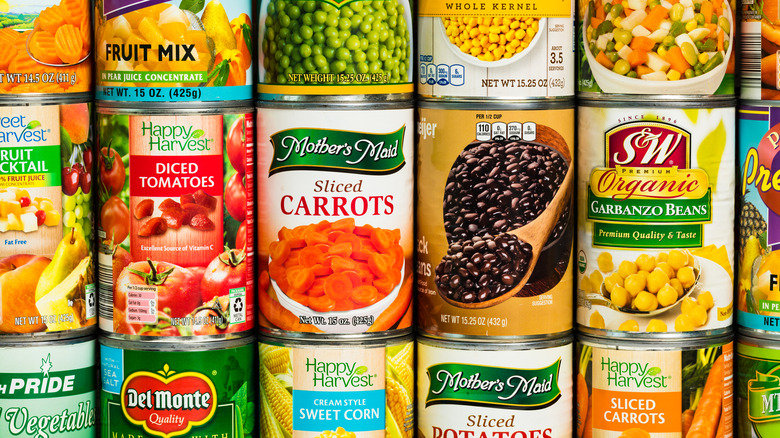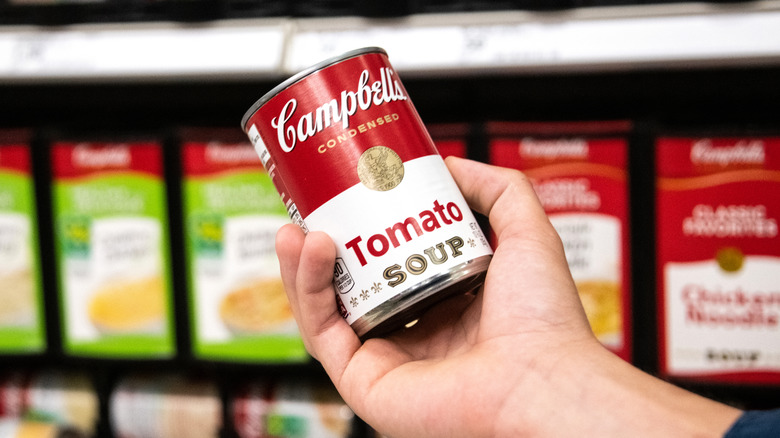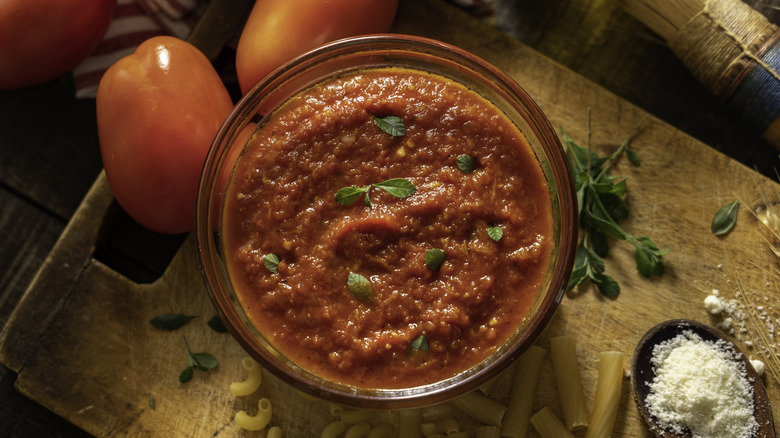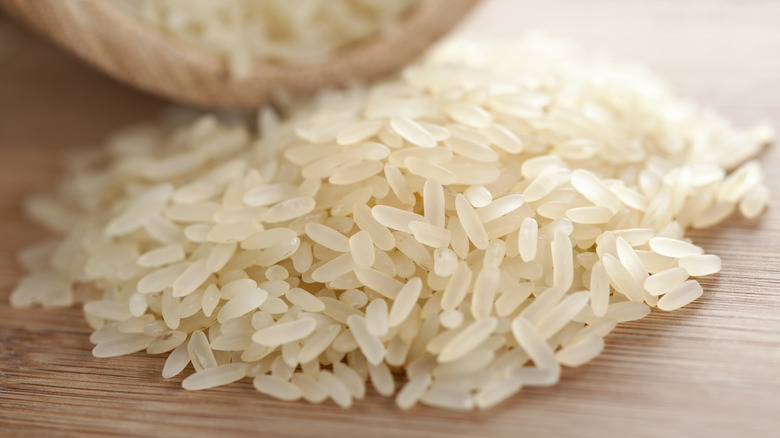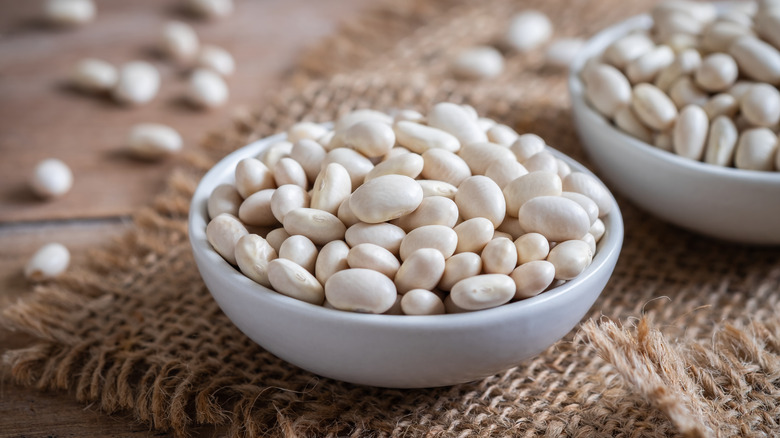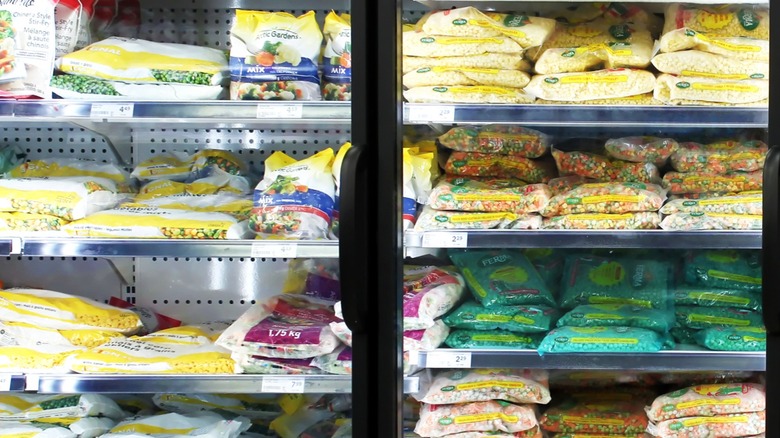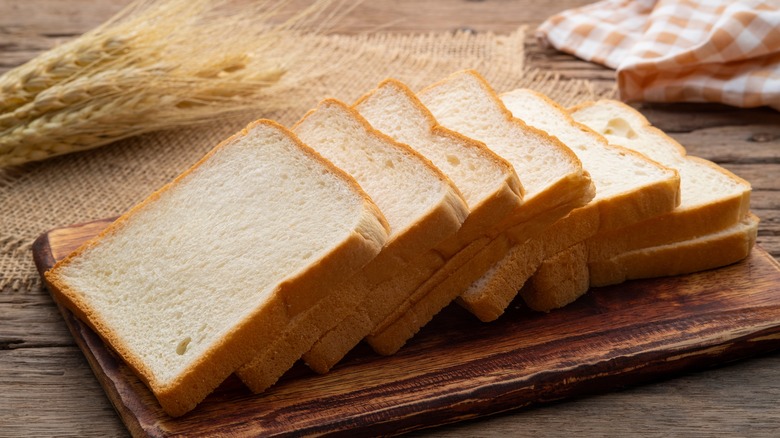The Best Items To Buy At Salvage Grocery Stores
Grocery prices have taken a sharp upward turn, with no signs of coming down. Stretching your shopping dollar has rarely been so necessary. Sales and in-store specials can only take you so far, which is why salvage grocery stores are such a relief. Think of these outlets as scratch-and-dent clearance centers where imperfect foods get a second lease on life. National chains like Grocery Outlet and Misfits Market specialize in reselling products that other retailers have either overstocked, discontinued, or deemed less than presentable, at appetizingly deep discounts. Though some dated stock may reflect less-than-peak freshness, all salvage items are safe to consume.
Beyond safety, there are certain items at these outlets that make for better purchases than others. Some of these locales rock a stock of options that rival traditional grocers. And the selection can rotate rapidly depending on the chain, with less familiar brands sharing shelves with the big names. We've made a shopping list of our picks for the best salvage grocery items for both your shopping and dining enjoyment. Grab a cart and prepare to save!
Canned vegetables
Few food options are better for loading your larder on a budget than canned vegetables, and few stores stock more budget-friendly selections than grocery salvage chains. Canned vegetables also have some of the longest shelf life of any food on your list and last for years, which makes loading up on these tinned treasures from your local markdown retailer an even tastier prospect. You'll find an impressive range of the most useful choices, including corn, beans, and tomatoes.
Whether your weekly menus include homemade casseroles or entrees served with a variety of sides, shopping for discount canned vegetables lets you pick up more of your favorites to have on hand for future meals. To make sure you get the cans you need at the best prices, head for the salvage grocery store before making your regular rounds at a full-priced retailer.
Though scratch-and-dent and torn labels are a natural part of the salvage experience, the Food & Drug Administration (FDA) advises steering clear of cans that bulge unexpectedly. This can be an indication that the contents have expanded due to unwanted bacteria growth, which would quickly ruin the bargain by making you sick.
Canned soup
There's nothing better than cracking open a can of soup on a night when cooking a more elaborate dinner just isn't in the cards. You can even transform a basic canned soup into a more exciting meal with a few extra ingredients. With this tinned treasure taking up one of the higher priced spots on the grocery store stock market ticker, it's a relief to know you can find reduced options at discount grocers on a regular basis. Common brands like Campbell's and Progresso prone to increasing prices make frequent appearances, as well as more mindful soups like Amy's or Healthy Choice. Since salvage brands regularly rotate their offerings, remember that you might find new choices on each visit, at prices that encourage you to try something different without overspending.
Soups in undamaged cans will last from two to five years unopened on the shelf, according to the U.S. Department of Agriculture (USDA). However, due to its high acidity level, tomato soup should be consumed within two years. Load up for a cozy cold-weather feast without fear of having to run to the store when the forecast insists you stay at home. Grab a few extra cans to have on hand for easy lunches and for adding to slow-cooker recipes.
Cereal
Have you seen the ridiculous price of breakfast cereal at large grocery shops lately? These boxes of grain and sugar are at such a premium that you'd think some of them came with the keys to a Mercedes buried at the bottom of the box. Even prices for the bagged store brand versions of timeless favorites have been creeping up to less-than-desirable levels. Swing by your local salvage grocery store or check the clearance aisle for sweet reductions so you can put cereal on your table for less. A little discount detective work that roots out rock-bottom prices can drop a box of your favorite crispies by 40% or more. You can also pick up hot cereals like oatmeal and creamed wheat for the more discerning breakfast diners in your pack.
Because cereal shopping can be tricky business at any price, remember to read the labels to be aware of sugar content and allergen information. Some promotional cereals may have ingredient lists that read more like a candy bar than a breakfast food, which might make you think twice about the dollar-saving deal in your hand.
Chips
For families with snackers and lunch box packers, buying chips at big-box stores can really put your grocery money in a crunch. With shrinkflation taking a few additional bites out of every bag, the struggle to find good options has become a salty endeavor. Luckily, there are racks of choices at salvage grocers that make it easy to put your chips on the table. Sometimes you'll see the big names like Lay's and Doritos with their bags all puffed up at the front of the display, and other times you may find one-offs filled with quality content that your family loves just as much as their more famous counterparts.
Prices jumping by 10% or more among the tip-top chip manufacturers are inspiration enough to give these more modest bags a fair shake and see if you can make do with a less-expensive discount chip. Freshness counts with potato and corn chips as much as it does with cheese puffs and veggie chips. No matter what your potential purchase might be, make sure the date on the bag lines up with your expectations. Careful shopping will prevent you from ending up with a chip on your shoulder.
Peanut butter
Even though peanut butter is an overall healthy foodstuff to keep on hand, the price per jar has been sneaking up in recent years, making it less convenient to add to your shopping list. Anyone who has an abiding passion for peanut butter sandwiches can cruise the markdown aisles to get a substantial break on their grocery bill. Pick up some extra jars so you're always stocked when the craving for a quick snack strikes.
Peanut butter choices at some locations may include lesser-known brands, which can make for fun discoveries. You'll want to double-check the labels to be sure the ingredients are in line with what you want — many products contain added sugar, salt, and oil. Eagle-eyed shoppers may even find options that combine jelly and peanut butter in a single jar, cutting down grocery expenses in a more creative manner. You'll be getting your PB practically for peanuts, and you'll be able to spread your food dollar a lot further, too.
Pasta sauce
You shouldn't have to choose between topping your pasta and making your car payment. With drastic discounts on jarred and canned pasta sauces lining the shelves at discount grocery chains, you can have both. If you're building out a pantry stash for future use, your best bets are red sauces; these generally have quality dates of up to one year (per Eat By Date). White sauces may reach their peak within six to eight months. If you're planning on regular use, you can count on savings with either option. Clever home chefs can make their money go even further by snatching up basic canned tomato sauce and adding their own herbs and mix-ins to create a simple custom marinara. Consider buying a variety to give yourself options in the kitchen.
If your family has a taste for specific brands, you can also scout your salvage grocery for recognizable names like Ragú and Prego, which feature regularly on store shelves. You may even stumble upon gourmet surprises like deluxe jars from Rao's during your money-saving missions. Discount chains are prone to surprising their shoppers with one-off shipments of these higher-end products, which can make return visits a fun food-finding adventure.
Rice
As a long-lasting dry good used in so many dishes, rice is a must-have for money-conscious consumers. As global rice prices soar to levels not seen in over a decade, flabbergasted shoppers can take comfort in knowing salvage grocery outlets are on the case (though you don't have to buy an entire case to reap the benefits). Though white rice is bound to be the default, you may run into jasmine, long-grain brown, and even quick cook boxed rice for multi-faceted meal prep at a fraction of the regular price. The array of culinary feasts you can create with this properly priced ingredient will keep you experimenting with delicious rice-based meals.
Getting a deal on rice is only worth the trouble if you can keep it fresh long enough to use it. While white rice has a lifespan of just about forever if stored sealed in your cabinet or pantry, whole grain options like brown rice can last around six months in similar conditions (via USA Rice). If you need to store it longer, simply toss it in the fridge or freezer until you are ready to cook.
Dried beans
Dried beans may not top your shopping list or be front-of-mind when considering your dining options. But bagged beans are cheaper than their canned counterparts, making them a fantastic item to pile into the salvage grocery cart. Even if you're not sure how you'll use them, having them on hand gives you options for those unexpected moments when hearty meals are on the menu and your can supply has been depleted. Finding other legumes like chickpeas and lentils hanging out on the dried bean scene will expand your menu and your money even further, offering highly affordable meals for plant-based eaters who know all too well how expensive vegan and vegetarian eating can be.
There's a bit of a time element as well as a learning curve when preparing your bargain-basement beans from their dried state. Luckily, most labels have instructions for proper prep. If you're slick enough in the kitchen, you can even transform dried chickpeas into chickpea flour, perfect for healthy scrambles as well as gluten-free options where wheat flour is a no-go.
Bottled water
Why get soaked buying bottled water at your usual stop-and-shop when you can find equal options served up at great discounts at a price-slashing salvage store? The disparity in bottled water prices can make it challenging to choose the right drip to sip. Even warehouse stores known for their bulk pricing like to sell water at higher prices. But if you're not picky about bottled water brands, you can keep from going underwater financially by looking at the lower-priced possibilities at your local bargain store.
While you may not find exactly what you're used to, the dazzling prices of discount outlet water might be refreshing enough to convince you to go with the flow. Bottled water is largely a luxury purchase, which means manufacturers and retailers charge a lot more for it than what is reasonable. If this pre-packaged beverage is part of your grocery regimen and you can't escape the ebb and flow, at least make sure you're paying sensibly for it.
Frozen foods
In addition to the lasting freshness of most frozen foods, having a freezer filled with ready-to-cook possibilities makes weeknight dinners much more doable, especially after a busy day of work, school, and sports practice. Salvage shops keep their deep freezes loaded up with microwavable dinners and burgers, fruits, veggies, fries, and tots, as well as more elaborate options like lasagna and chicken. You may also find single-serving meals that heat up nicely in the office break room for work lunches that don't require at-home labor. Don't forget the array of frozen treats, ice pops, and ice cream goodies to choose from in the discount grocery freezer section. These reduced-priced ready-to-serve delights will make planning desserts and parties a more enjoyable prospect.
Because the dates on bags of frozen food indicate peak freshness, you can build up a cache and eat your way through your bargains before the flavor takes a turn and leaves you in the cold. The trick is to make sure to bring your older foods to the front so they get consumed first while storing newer items in the back for future use.
Bread
Bread is a cornerstone of the grocery salvage concept, with day-old loaves and dinner rolls appearing in their own sections and dedicated outlets for decades. Anything less than squeezable that hits its best-by date heads directly for the markdown list, even if the product is still fresh and completely edible. So why should you shell out increasing amounts of dough today for bread that's bound to be reduced in price tomorrow? By shopping for white, whole wheat, and specialty blends at salvage grocery chains, you can pocket the extra while feeding your family.
If you stumble upon a bread bargain you can't resist, stocking up on the lower-priced options isn't a bad idea — as long as you have freezer space to store the extra until you need it. To get the longest life out of your bread purchases, wrap loaves in plastic wrap or foil and place them in freezer-safe bags for extra protection. When you're ready to eat it, let the bread thaw on the counter or in the fridge until soft. With a little salvage grocery bread salvation, you'll always be ready for toast or a sandwich at a moment's notice.
Protein bars
Fitness fiends know the struggle of finding affordable supplements, especially when it comes to protein bars. These handy meal replacement products are expensive enough to break your budget if you don't have more cost-effective prospects. Shopping clearance sections and grocery outlets will show you the way to find affordable bars that pack in the protein without draining your 401K while you train for your 10K. Astute shoppers have found bars at record-low prices, so you can knock the bloat out of an inflated fitness food budget.
Bargain protein bars do sometimes outlive their freshness while sitting in salvage grocery store displays. You may tear into your bar and discover the chocolate coating has gone a bit pale, or the texture is far less chewy than anticipated. Be sure to check the labels on the boxes so you can find the bars that are farthest out from their peak performance date. You'll have a better chance of unwrapping a winner, and you'll be a champ in the salvage grocery competition.

